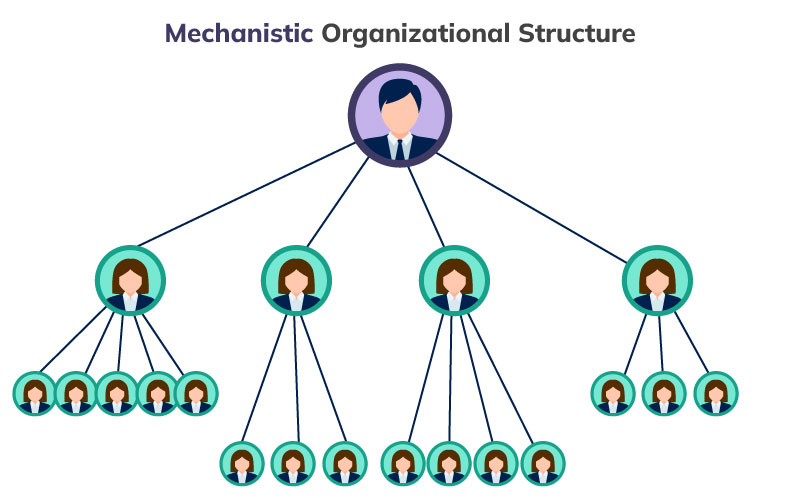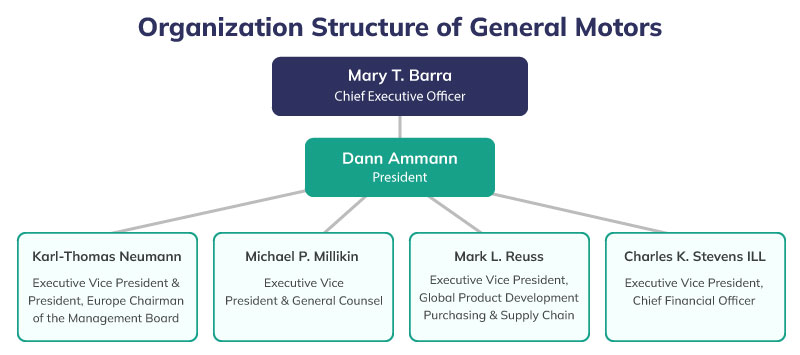Introduction to Mechanistic Organizational Structure
Mechanistic organizational structure refers to the organizational structure with centralized authority and divisions between departments that work independently. The mechanistic organizational structure is characterized by a hierarchical, well-defined, authority, and bureaucratic organizational structure. Hence, the mechanistic organizational structure emphasizes a strict chain of command with fine divisions of labor. It is characterized by a vertically oriented organizational structure and the central power lies with the top management team in the organization. Thus, the mechanistic organizational structure includes a wide span of control.

Table of Contents
Advantages of Mechanistic Organizational Structure
The mechanistic organizational structure is useful to promote clarity in the role of each employee and helps to promote understanding among the employees about the accountability of various tasks. The advantages of the mechanistic organizational structure are discussed as follows-
Stability- The mechanistic organizational structure is relatively stable and helps to promote consistency in the organization. This structure is mainly used by manufacturing organizations as the mechanistic organizational structure helps the organization to maintain clarity in the operation and is useful to comply with various standards and quality requirements.
Low cost- The mechanistic organizational structure can help to ensure cost efficiency as qualified people are appointed at the specialized position which helps in lowering the supervisory cost and promoting organization efficiency.
Communication effectiveness- The mechanistic organizational structure involves a fixed channel of communication where the individual can present their concerns to the immediate managers which can help in dealing with various problems and issues effectively. Hence, the use of mechanistic organizational structure helps to ensure effective management of the organizational operations by promoting employee effectiveness and maintaining clarity in the role of each individual.
Disadvantages of Mechanistic Organizational Structure
Despite the benefits of mechanistic organizational structure, it also suffers from various limitations which are discussed as follows-
Local viewpoint- The mechanistic organizational structure involves an autocratic style of leadership which limits the input from the non-managerial employees and results in a decline in motivation among the employees. Due to the autocratic style of leadership in the organization and lack of input from the non-managerial employees, it can be difficult to deal with various unforeseen situations due to resistance from the employees.
Workload and employee turnover- The employees working in the organization with the mechanistic organizational structure may face a higher workload due to silos in the organization which can also result in an increase in employee turnover due to lack of autonomy. The employees can face role rigidity in the organization due to hierarchical working.
Limited autonomy- Limited autonomy to the employees in the organization can make it very challenging for the employees to collaborate which can then result in a decline in the creativity of the employees in the organization and thereby a decline in organizational productivity.
Example of Mechanistic Organizational Structure
The mechanistic organizational structure is suitable for the organization that works in a stable and simple work environment and the managers can integrate various activities through formal channels over the hierarchical layers which helps in the effective management of various organizational operations. An example of an organization that uses the mechanistic organization structure is General Motors. Why does General Motors use the mechanistic organizational structure? The simple answer is that an organization with many people and functions requires a clear hierarchy and order in the organization to effectively manage a large number of people. The other reason for the mechanistic organizational structure is that General Motors works in a simple working environment. Now, you may be thinking that the car market fluctuates with the change in the economy but General Motors focus on building cars and trucks where all the functions generally remain the same across all the divisions which require the organization to adopt the mechanistic organizational structure to effectively manage specialized tasks over the centralized decision-making structure.

The organizational structure of General Motors shows that hierarchical decision-making helps to facilitate clarity in the role of each employee. Moreover, specialization is maintained in the organization with the presence of qualified professionals in managerial roles.
FAQs
Under what conditions is an organization likely to use mechanistic organizational structure?
Organizations that are working towards maximizing their efficiency and minimizing costs are the ones likely to use the mechanistic organizational structure.
Can a mechanistic structure hinder employee empowerment and engagement?
Yes, the rigid nature of mechanistic structures may limit employee empowerment and involvement in decision-making processes, leading to reduced engagement and job satisfaction.
Previous Structure
Decentralized Organizational StructureNext Structure
Network Organizational Structure
 Proof Reading
Proof Reading  Copy Writing
Copy Writing  Resume Writing
Resume Writing  Blogs
Blogs Guides
Guides SOP's
SOP's Student Resources
Student Resources Research Topics
Research Topics Login
Login Register
Register